Granny’s Bread and Butter Pickles Recipe
This post may contain affiliate links, which means that I may receive a commission if you make a purchase using these links. As an Amazon Associate I earn from qualifying purchases.
These old-fashioned bread and butter pickles have a crisp texture and a balanced sweet and sour flavor. The slightly sweet tangy flavor makes them perfect for topping your favorite burgers and sandwiches.
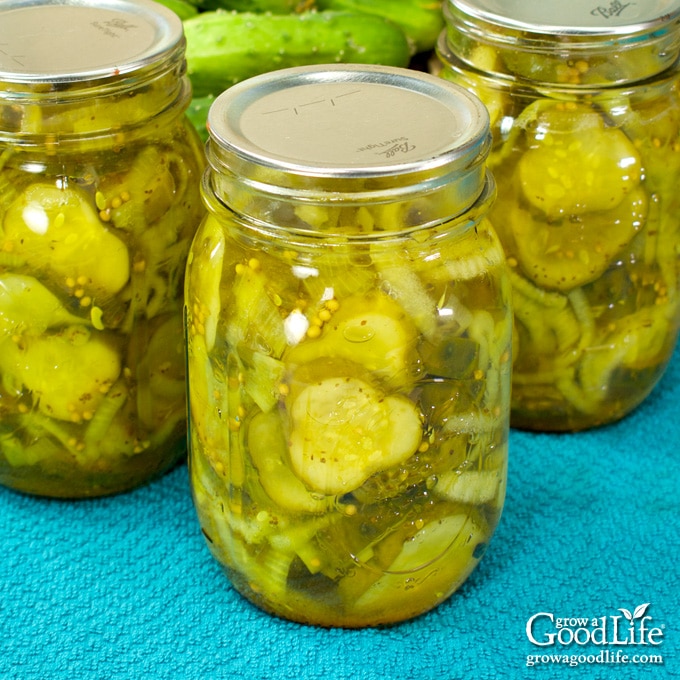
“I love pickles!” my husband said as I planned the garden soon after moving to our property.
With this in mind, I planned on growing a bunch of pickling cucumbers. I was not a fan of pickles, so normally I grew only a few cucumber plants to eat fresh and in salads. However, this was the year I acquired a lot of canning jars, and I was determined to fill each one with garden grown goodness.
Cucumbers ended up exceeding my expectations that year and were my most prolific producers. I barely kept up with processing them into endless batches of pickles. I made bread and butter pickles, kosher dill pickle spears and sweet pickle relish from the Ball Blue Book Guide to Preserving.
Soon my shelves were filled with jars and jars of pickles. We had so many pickles that I began asking my husband if he wanted pickles with almost meal. I gave jars of pickles and relish away and still had shelves full years later.
Thankfully, I learned my lesson and now only plant just a few cucumber plants to provide enough for fresh eating and a few batches of canned pickles and relish.
I have never been a big fan of pickles until I tried this recipe from a dear friend who was like a Granny to many. I call this recipe Granny’s Bread and Butter Pickles in her honor.
Tips for Canning Bread & Butter Pickles
These old-fashioned bread and butter pickles are made from cucumbers, onions and pickling spices. They are tangy, sweet, and crunchy—a perfect addition to any sandwich, hamburger, or hot dog. Here are tips for home canning bread and butter pickles:
Select crisp, freshly harvested pickling cucumbers
Pickling cucumbers are short, thin skinned cucumbers that are primarily used for processing or pickling. Skip the waxed cucumbers at the grocery store. The wax prevents the pickling liquid from penetrating the cucumber.
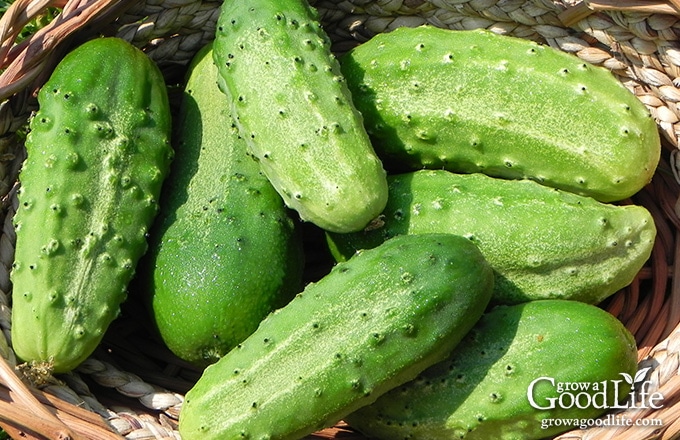
Use pickling salt
Table salt contains iodine and anti-caking agents that can darken pickles and cause cloudiness in your jars. Instead, use pickling salt, which is also called canning salt.
Use commercial vinegar with at least 5% acidity
- Apple cider vinegar is made from fermented apples. It will darken your pickles slightly, but adds a nice flavor.
- White vinegar is clear vinegar made by distilling corn and rye. Choose an organic brand to avoid genetically modified corn.
Steps for Canning Pickles
If you are new to canning or haven’t canned in a while, it may be helpful to review this article on water bath canning at the National Center for Home Food Preservation website.
A more detailed and printable recipe can be found at the bottom of this article, but these are the general steps for making and canning bread and butter pickles:
Step 1: Gather your canning equipment
- Water bath canner with canning rack
- 5 pint sized canning jars
- Lids and bands (new lids for each jar, bands can be reused)
- Canning tools: jar lifter, canning ladle, funnel, and bubble popper
- Plus basic kitchen supplies such as a large sauce pot, large bowl, small pot, towels, knife, and a cutting board
Step 2: Prepare your cucumbers and onions
Wash cucumbers well under running water and cut into 1/4-inch slices discarding ends. Peel onion and slice thinly.
Combine the cucumber and onions a large bowl. Scatter the canning salt over the top, cover with the ice and water, and let stand for about 3 hours.
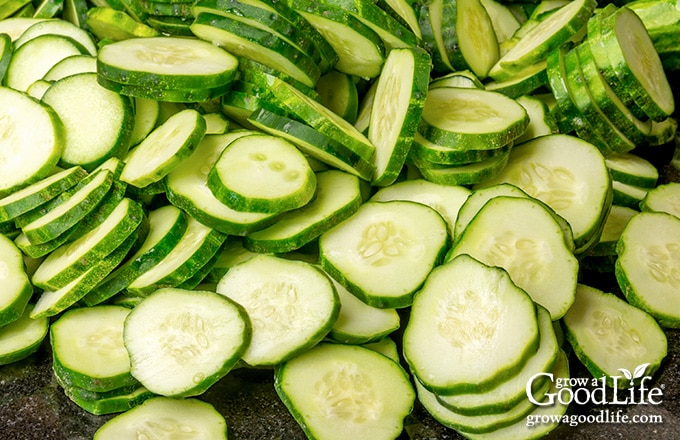
Step 3: Prepare your canning equipment
Wash your jars, lids, bands, and canning tools in warm, soapy water. Rinse well, and set the lids, bands, and tools aside to air dry until you are ready to use them.
Setup your water bath canner with the canning rack on a large burner of your stove. Place the jars upright in the canner, and add water to cover. Bring the canner to a simmer (180˚F) for 10 minutes, and keep the jars hot until you are ready to fill them.
Step 4: Make the pickling brine
In a large pot, combine sugar, mustard seed, celery seed, ground turmeric, peppercorns, and vinegar. Heat just to a boil.
Drain and rinse the cucumbers and onions under fresh water. Add the drained cucumber and onion slices to the pot of pickling brine and return to boil. Reduce heat and keep warm as you fill your jars.

Step 5: Can the pickles
Lay a kitchen towel on the counter. Use the jar lifter to remove a hot jar from the canner, drain, and place on the towel. Keep the remaining jars in the canner, so they stay warm.
Place the canning funnel on the jar, and add the warm pickles and brine to the jar, leaving 1/2-inch headspace. Run the bubble popper through the jar to release any trapped air bubbles. Make sure all the pickles are submerged under the brine. Remove any that stick out, and adjust the headspace again if needed.
Wipe the rim with a damp towel to remove residue. Center a lid on the jar, place the band over the lid, and screw it on until fingertip tight. Place the jar back into the canner, and repeat with the rest of the jars.
Adjust the water level so it is covering the jars by several inches, bring the pot to a boil, and process the jars for the times indicated in the recipe below.
Let the jars cool, test the seals, label and date the jars, and store the canned pickles in a cool, dark location. Let the pickles stand for about 4 weeks to develop flavor.
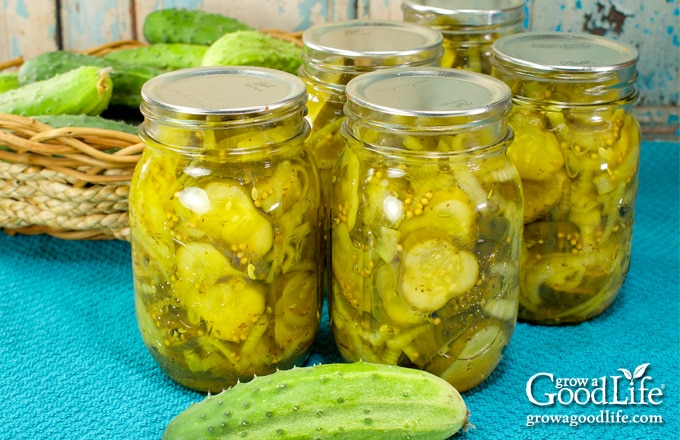
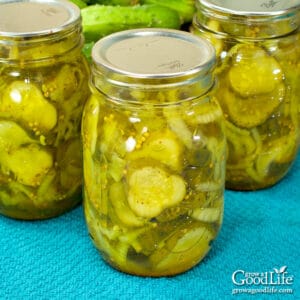
Granny's Bread and Butter Pickles Recipe
Ingredients
- 3 pounds pickling cucumbers
- 1 pound onions
- 1/4 cup canning or pickling salt
- 2 quarts crushed ice or ice cubes and water
- 1 cup sugar
- 1 tablespoon yellow mustard seed
- 1 teaspoon celery seed
- 1 teaspoon ground turmeric
- 1/2 teaspoon black peppercorn
- 3 cups apple cider vinegar 5% acidity (or white vinegar)
Instructions
Prepare your cucumbers and onions:
- Wash cucumbers, cut into 1/4-inch slices discarding ends. Peel and thinly slice onions. Combine sliced cucumber and onions a large bowl.
- Sprinkle canning salt over the top of the cucumbers and onions, cover with ice and water, and let stand for 3 hours.
Prepare your canning equipment:
- Wash your jars, lids, screw bands, and canning tools in hot soapy water. Rinse thoroughly to remove all suds. Set aside to air dry on a clean kitchen towel.
- Place the jar rack into water bath canner, place jars in the canner, and add water to cover. Bring the canner to a simmer (180˚F) for 10 minutes, and keep the jars hot.
Make your bread and butter pickles
- In a large pot, combine sugar, mustard seed, celery seed, ground turmeric, peppercorns, and vinegar. Heat just to a boil.
- Drain and rinse the cucumber and onions under fresh water. Add the drained cucumber and onion slices to the large pot and return to boil. Reduce heat and keep warm as you fill your jars.
Can your bread and butter pickles
- Spread a kitchen towel on the counter. Use the jar lifter to remove a hot jar from the canner, drain, and place on the towel. Keep the remaining jars in the canner, so they stay warm.
- Use your canning funnel and ladle to pack the hot cucumbers and onions loosely into the jar. Ladle the hot brine over the pickles, and maintaining a 1/2 inch headspace.
- Run the bubble popper through the jar to release any trapped air bubbles. Make sure all the pickles are submerged under the brine. Remove any that stick out, and adjust the headspace again if needed.
- Wipe the rim to remove any residue, center a lid on the jar, and screw on a band until it is fingertip tight. Use your jar lifter to place the jar back into the canner, and repeat with the remaining jars.
- Once all the jars are in canner, adjust the water level so it is 2 inches above the jar tops.
- Cover the canner and bring to boil over high heat. Once water boils vigorously, continue boiling and process pickles for 10 minutes at altitudes of less than 1,000 feet. Adjust processing time for your altitude if necessary (See Note).
- When processing time is complete, turn off heat, remove the cover, and allow the canner to cool down and settle for about 5 minutes.
- Spread a dry kitchen towel on the counter. Remove the cover by tilting lid away from you so that steam does not burn your face.
- Use the jar lifter to remove the jars from canner and place on the towel. Keep the jars upright, and don't tighten bands or check the seals yet. Let the jars sit undisturbed for 12 to 24-hours to cool.
- After 12 to 24-hours, check to be sure jar lids have sealed by pushing on the center of the lid. The lid should not pop up. If the lid flexes up and down, it did not seal. Refrigerate jar and use up within a week.
- Remove the screw on bands and wash the jars. Label and date the jars. Store in a cool, dark location. Allow 4-5 weeks for the pickles to develop their flavor. Use within a year. Yields about 5 pints depending on the size of your cucumbers.
Notes
Nutrition
This recipe was originally published July 5, 2015. It has been reviewed and updated with additional information and new photos.
If you know someone who doesn’t like pickles, let them taste these pickles. Granny’s Bread & Butter Pickles are so sweet that it may just convert them into a pickle lover too.
Canning Resources:
- USDA Complete Guide to Home Canning
- Ball Blue Book Guide to Preserving
- Storing Home Canned Goods – National Center for Home Preservation
- Causes and Possible Solutions for Problems with Canned Foods – National Center for Home Preservation
You May Also Like These Canning Recipes:
- Spiced Apple Jelly Recipe with No Added Pectin
- How to Can Carrots for Food Storage
- Homemade Applesauce for Canning
- Crabapple Jelly with No Added Pectin
- Seasoned Tomato Sauce for Home Canning
Good planning is key to a successful vegetable garden
Whether you are new to growing your own food or have been growing a vegetable garden for years, you will benefit from some planning each year. You will find everything you need to organize and plan your vegetable garden in my PDF eBook, Grow a Good Life Guide to Planning Your Vegetable Garden.


Hi,
Over the years, I’ve made and preserved relish and jams. This was my first time making pickles. I didn’t have enough brine to top off my last two jars. So, I heated up a 3 to 1 vinegar/sugar solution to top them off. Was that the correct thing to do? If so, it might be a nice idea for us newbies if you could suggest what to do if you run short of liquid.
Thanks for the recipe.
Hi David, I’m so glad you gave the recipe a try, and congratulations on your first batch of pickles! It’s actually pretty common to run short on brine, even when you measure carefully. To help with this issue, I actually increased the brine amount in this recipe compared to the original, but it can still happen. The cucumbers can vary in how tightly they pack into jars, and depending on how much liquid they give off during the salting step, the final volume of brine needed can shift a bit from batch to batch.
You did the right thing by quickly making up more hot brine with the same vinegar-to-sugar ratio. That keeps the flavor and the acidity safe for canning. I love your suggestion about adding a note for what to do if you come up short. I’ll add that tip so other first-time pickle makers won’t be caught off guard. Thanks so much for the feedback, and I hope you enjoy every crunchy bite of your pickles!
Hi! I printed your recipe for Granny’s Bread and Butter Pickles several years ago. I was just comparing it to the one that is posted now and the old one that I printed calls for 2 cups apple cider vinegar and the one currently on your post calls for 3 cups apple cider vinegar. Could you please inform me which is the correct amount so that I make a safe and approved product?
Hi Heather, You’re absolutely right! The original version of the recipe called for 2 cups of apple cider vinegar. However, over time I received quite a few messages from readers saying they didn’t have enough brine to fully cover the pickles, which can happen depending on the size of the cucumbers and how they are packed.
To make the recipe more foolproof and ensure everyone has enough brine, I adjusted the vinegar to 3 cups. It’s always better to have a little extra brine than not enough! Rest assured, both versions are safe. The change just gives a more reliable result for a variety of packing styles.
Great recipe with lots of detail. Weighed my cucumbers first, so was surprised that with 3 cups of apple cider vinegar I didn’t have enough brine to cover all of the jars. I haven’t tasted them yet but they look good.
LuAnn, I’m glad you found the recipe helpful. The amount of brine can sometimes vary depending on the size and shape of the cucumbers, so it’s always a good idea to have a bit extra just in case. I hope they turn out delicious when you taste them!
I used tongs to lightly push the pickles down in the brine. I had about 1 cup left over at the end.
What happens uf I leave the cucumbers in the cold brinen8 hours instead of 3?
Brenda, Soaking the cucumbers in the salted ice water helps draw out excess moisture and keeps them crisp during the canning process. If you leave them in the brine for 8 hours instead of 3, it won’t ruin the recipe, but the cucumbers may end up a bit saltier and slightly softer, depending on how thick they are sliced. Some recipes even soak overnight, so you’re still within a safe range.
Can I add red pepper to add spice to these pickles? I love wickles
Carol, Yes, you can add up to 1 dried pepper or up to 1 teaspoon of dried chile pepper flakes to each jar to add spiciness. If you’re interested in safely customizing your pickles, check out my post on how to safely modify pickle and relish canning recipes.
For this recite, can you heat the brine without adding the cucumbers and onions and place cucumbers and onions in the jars and pour the brine mixture over them?
Hi Sherry, This bread and butter pickle recipe calls for hot packing, which means heating the cucumbers and onions in the hot brine before packing them into warm jars. For best results and food safety, I recommend following the recipe as written, heating the brine with the cucumbers and onions together before packing into jars.
Great recipe 👍.
I’m just a wee bit curious, You said previously “avoid genetically modified corn”. My only question is why?
Brian, Thank you for your comment, and I’m glad you enjoyed the recipe! When I mention avoiding genetically modified (GM) corn, it’s because most of my readers prefer to stick with organic or non-GMO products. That said, it’s completely up to you and your comfort level!
Thanks so much for the detailed advice on canning! The most informative I’ve seen, I learned a lot and my jars sealed with no problems this time (I’ve had problems in the past) so that’s great.
FYI, I used regular cucumbers from my neighbours garden, not pickling cucumbers, but I weighed them to equal 3 pounds, which were 4 medium cukes. I ended up being short about 1/2 cup of brine. It might be just me, but just a heads up to maybe make a little more brine to cover the last jar (it made 4 3/4 pint-sized jars).
Nancy, Thank you so much for your kind words, and I’m so glad the detailed advice helped you get those perfect seals this time—great job! 😊
It’s not uncommon for yields to vary, especially when it comes to pickling vegetables like cucumbers. The size, shape, and how tightly they’re packed into the jars can all affect how much brine is needed. It’s a good idea to have a little extra brine on hand just in case. You can scale up the brine recipe by a small amount to ensure everything is covered in future batches. I’m thrilled to hear that your pickles turned out well! Thank you for the lovely feedback!
Is it safe to double this recipe for canning?
Kim, Yes, it is safe to double this recipe for canning.